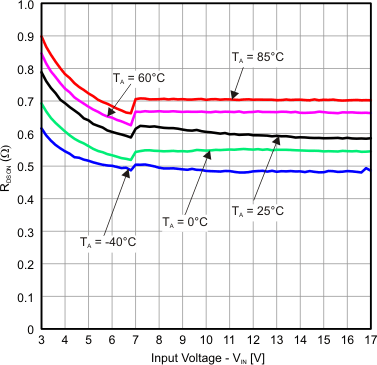ZHCS862E March 2012 – May 2017 TPS62125
PRODUCTION DATA.
- 1 特性
- 2 应用
- 3 说明
- 4 修订历史记录
- 5 Pin Configuration and Functions
- 6 Specifications
- 7 Detailed Description
- 8 Application and Implementation
- 9 Power Supply Recommendations
- 10Layout
- 11器件和文档支持
- 12机械、封装和可订购信息
6 Specifications
6.1 Absolute Maximum Ratings
(1)| MIN | MAX | UNIT | |||
|---|---|---|---|---|---|
| Pin voltage(2) | VIN | –0.3 | 20 | V | |
| SW (DC) | –0.3 | VIN + 0.3V | V | ||
| SW (AC, less than 10ns)(3) | -3.0 | 23.5 | V | ||
| EN | –0.3 | VIN + 0.3 | V | ||
| FB | –0.3 | 3.6 | V | ||
| VOS, PG | –0.3 | 12 | V | ||
| EN_hys | –0.3 | 7 | V | ||
| Power good sink current | IPG | 10 | mA | ||
| EN_hys sink current | IEN_hys | 3 | mA | ||
| Maximum operating junction temperature, TJ | –40 | 125 | °C | ||
| Storage temperature, Tstg | –65 | 150 | °C | ||
(1) Stresses beyond those listed under Absolute Maximum Ratings may cause permanent damage to the device. These are stress ratings only and functional operation of the device at these or any other conditions beyond those indicated under Recommended Operating Conditions is not implied. Exposure to absolute–maximum–rated conditions for extended periods may affect device reliability.
(2) All voltage values are with respect to network ground terminal GND.
(3) While switching
6.2 ESD Ratings
| VALUE | UNIT | |||
|---|---|---|---|---|
| V(ESD) | Electrostatic discharge | Human body model (HBM), per ANSI/ESDA/JEDEC JS-001(1) | ±2000 | V |
| Charged-device model (CDM), per JEDEC specification JESD22-C101(2) | ±1000 | |||
(1) JEDEC document JEP155 states that 500-V HBM allows safe manufacturing with a standard ESD control process.
(2) JEDEC document JEP157 states that 250-V CDM allows safe manufacturing with a standard ESD control process.
6.3 Recommended Operating Conditions
| MIN | NOM | MAX | UNIT | |||
|---|---|---|---|---|---|---|
| VIN | Supply voltage | 3 | 17 | V | ||
| Output current capability | 3 V ≤ VIN < 6 V | 200 | mA | |||
| 6 V ≤ VIN ≤ 17 V | 300 | |||||
| TA | Operating ambient temperature (1) (Unless Otherwise Noted) | –40 | 85 | °C | ||
| TJ | Operating junction temperature, | –40 | 125 | °C | ||
(1) In applications where high power dissipation and/or poor package thermal resistance is present, the maximum ambient temperature may have to be derated. Maximum ambient temperature (TA(max)) is dependent on the maximum operating junction temperature (TJ(max)) and the maximum power dissipation of the device in the application (PD(max)); for more information about traditional and new thermal metrics, see the Semiconductor and IC Package Thermal Metrics application report.
6.4 Thermal Information
| THERMAL METRIC(1) | TPS62125 | UNIT | |
|---|---|---|---|
| DSG (WSON) | |||
| 8 PINS | |||
| RθJA | Junction-to-ambient thermal resistance | 65.2 | °C/W |
| RθJC(top) | Junction-to-case (top) thermal resistance | 93.3 | °C/W |
| RθJB | Junction-to-board thermal resistance | 30.1 | °C/W |
| ψJT | Junction-to-top characterization parameter | 0.5 | °C/W |
| ψJB | Junction-to-board characterization parameter | 47.4 | °C/W |
| RθJC(bot) | Junction-to-case (bottom) thermal resistance | 7.2 | °C/W |
(1) For more information about traditional and new thermal metrics, see the Semiconductor and IC Package Thermal Metrics application report.
6.5 Electrical Characteristics
TA = –40°C to 85°C, typical values are at TA = 25°C (unless otherwise noted), VIN = 12 V| PARAMETER | TEST CONDITIONS | MIN | TYP | MAX | UNIT | |
|---|---|---|---|---|---|---|
| SUPPLY | ||||||
| VIN | Input voltage range(1) | 3 | 17 | V | ||
| VOUT | Output voltage range | 1.2 | 10 | V | ||
| IQ | Quiescent current | IOUT = 0 mA, device not switching, EN = VIN, regulator sleeps | 13 | 23 | µA | |
| IOUT = 0 mA, device switching, VIN = 7.2 V, VOUT = 1.2 V, L = 22 µH |
14 | µA | ||||
| VIN = 5 V, EN = 1.1 V, enable comparator active, device DC/DC converter off | 6 | 11 | µA | |||
| IActive | Active mode current consumption | VIN = 5 V = VOUT, TA = 25°C, high-side MOSFET switch fully turned on (100% mode) | 230 | 275 | µA | |
| ISD | Shutdown current(2) | Enable comparator off, EN < 0.4 V,
VOUT = SW = 0 V, VIN = 5 V |
0.35 | 2.4 | µA | |
| VUVLO | Undervoltage lockout threshold | Falling VIN | 2.8 | 2.85 | V | |
| Rising VIN | 2.9 | 2.95 | V | |||
| ENABLE COMPARATOR THRESHOLD AND HYSTERESIS (EN, EN_hys) | ||||||
| VTH EN ON | EN pin threshold rising edge | 3 V ≤ V≤ 17 V | 1.16 | 1.20 | 1.24 | V |
| VTH EN OFF | EN pin threshold falling edge | 1.12 | 1.15 | 1.19 | V | |
| VTH EN Hys | EN pin hysteresis IN | 50 | mV | |||
| IIN EN | Input bias current into EN pin | EN = 1.3 V | 0 | 50 | nA | |
| VEN_hyst | EN_hys pin output low | IEN_hyst = 1 mA, EN = 1.1 V | 0.4 | V | ||
| IIN EN_hyst | Input bias current into EN_hyst pin | EN_hyst = 1.3 V | 0 | 50 | nA | |
| POWER SWITCH | ||||||
| RDS(ON) | High-side MOSFET ON-resistance | VIN = 3 V, I = 100 mA | 2.4 | 4 | Ω | |
| VIN = 12 V, I = 100 mA | 1.5 | 2.6 | ||||
| Low-side MOSFET ON-resistance | VIN = 3 V, I = 100 mA | 0.75 | 1.3 | |||
| VIN = 12 V, I = 100 mA | 0.6 | 1 | ||||
| ILIMF | Switch current limit high-side MOSFET | VIN = 12 V | 600 | 750 | 900 | mA |
| TSD | Thermal shutdown | Increasing junction temperature | 150 | °C | ||
| Thermal shutdown hysteresis | Decreasing junction temperature | 20 | °C | |||
| OUTPUT | ||||||
| tONmin | Minimum ON-time | VIN = 5 V, VOUT = 2.5 V | 500 | ns | ||
| tOFFmin | Minimum OFF-time | VIN = 5 V | 60 | ns | ||
| VREF_FB | Internal reference voltage of error amplifier | 0.808 | V | |||
| VFB | Feedback voltage accuracy | Referred to internal reference (VREF_FB) | –2.5% | 0% | 2.5% | |
| Feedback voltage line regulation | IOUT = 100 mA, 5 V ≤ VIN ≤ 17 V, VOUT = 3.3 V(3) | –0.05 | %/V | |||
| Feedback voltage load regulation | VOUT = 3.3 V; IOUT = 1 mA to 300 mA, VIN = 12 V(3) | –0.004 | %/mA | |||
| IIN_FB | Input bias current into FB pin | VFB = 0.8 V | 0 | 50 | nA | |
| tStart | Regulator start-up time | Time from EN high to device starts switching, VIN = 5 V |
50 | µs | ||
| tRamp | Output voltage ramp time | Time to ramp up VOUT = 1.8 V, no load | 200 | |||
| ILK_SW | Leakage current into SW pin(4) | VOS = VIN = VSW = 1.8 V, EN = GND, device in shutdown mode | 1.8 | 2.85 | µA | |
| IIN_VOS | Bias current into VOS pin | 0 | 50 | nA | ||
| POWER GOOD OUTPUT (PG) | ||||||
| VTH_PG | Power good threshold voltage | Rising VFB feedback voltage | 93% | 95% | 97% | |
| Falling VFB feedback voltage | 87% | 90% | 93% | |||
| VOL | PG pin output low voltage | Current into PG pin IPG= 0.4 mA | 0.3 | V | ||
| VOH | PG pin output high voltage | Open drain output, external pullup resistor | 10 | V | ||
| IIN_PG | Bias current into PG pin | V(PG) = 3 V, EN = 1.3 V, FB = 0.85 V | 0 | 50 | nA | |
(1) The part is functional down to the falling UVLO (Undervoltage Lockout) threshold
(2) Current into VIN pin
(3) VOUT = 3.3 V, L = 15 µH, COUT = 10 µF
(4) An internal resistor divider network with typ. 1 MΩ total resistance is connected between SW pin and GND.
6.6 Typical Characteristics
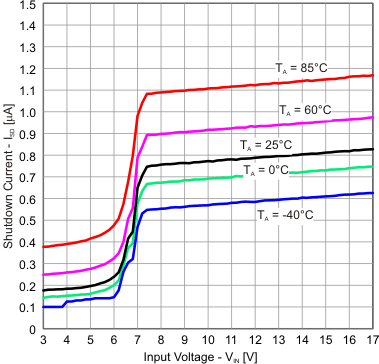 Figure 1. Shutdown Current vs. Input Voltage
Figure 1. Shutdown Current vs. Input Voltage
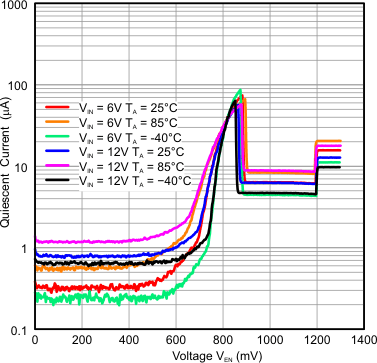 Figure 3. Quiescent Current vs. EN Voltage, Rising VEN
Figure 3. Quiescent Current vs. EN Voltage, Rising VEN
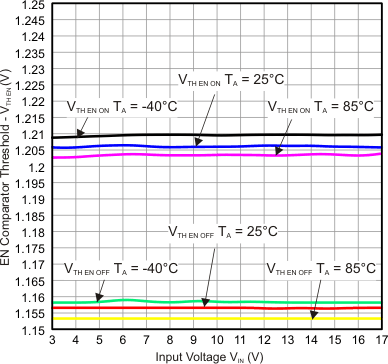 Figure 5. EN Comparator Thresholds vs. Input Voltage
Figure 5. EN Comparator Thresholds vs. Input Voltage
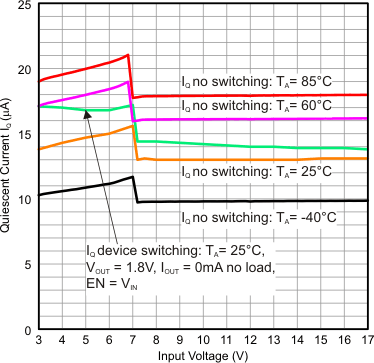 Figure 2. Quiescent Current vs. Input Voltage
Figure 2. Quiescent Current vs. Input Voltage
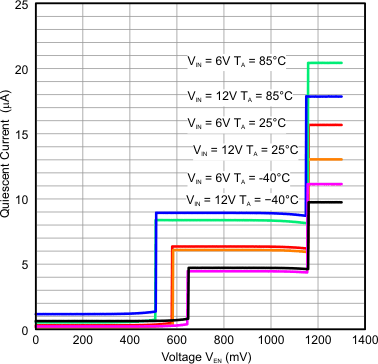 Figure 4. Quiescent Current vs. VEN Voltage, Falling VEN
Figure 4. Quiescent Current vs. VEN Voltage, Falling VEN
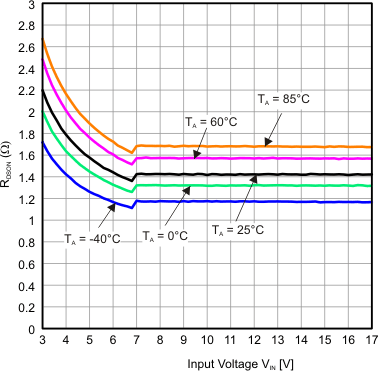 Figure 6. RDSON High-Side Switch
Figure 6. RDSON High-Side Switch
